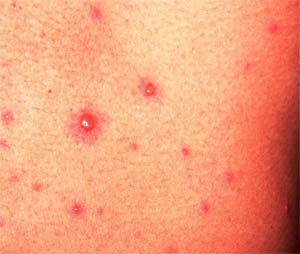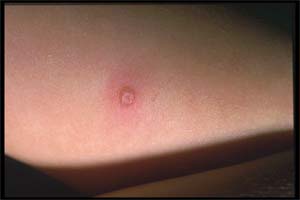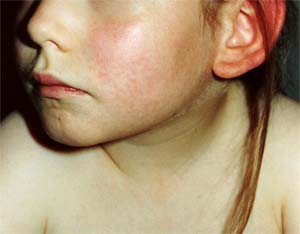Childhood rashes are a common problem, but determining the cause is not always easy. Find out about 4 infectious illnesses that are commonly associated with a skin rash.
Measles
Measles is a highly contagious viral illness that causes rash and fever in both children and adults. A vaccine against measles is available and recommended as part of the Australian Standard Vaccination Schedule.
What causes measles?
Measles is caused by a virus called Morbillivirus, a paramyxovirus.
What does measles rash look like?
The measles rash consists of separate pink/red lesions or blotches that become joined together as the rash spreads. The ‘spots’ are flat red areas, some of which are slightly raised up.
Koplik spots
About 3 to 4 days before the measles skin rash appears, small blue-white spots on a bright red background may appear inside the cheeks in the mouth. The spots are about 1-2 millimetres in diameter and are known as Koplik spots. Koplik spots usually fade and disappear after the measles rash starts on the skin, so you may not even notice them.
Where is the rash?
The rash starts around the ears and on the hairline and neck. After 1-2 days the rash may spread to the body, arms and legs and start to fade on the face. Measles rash may be itchy, but is not intensely itchy.
When is my child infectious?
A person with measles is infectious from 2 to 4 days before the rash appears until about 4 days after the rash has started — which is often when it starts to disappear.
If a person has suspected measles they should stay home from childcare, school or work until this period is over or the diagnosis has been discounted. They should avoid contact with anyone not known to be immune to measles during this time.
How long will it last?
The measles rash will last 4-7 days.
How is measles caught?
The measles virus is very contagious and is spread by infected people coughing out droplets infected with the virus which other people then breathe in and so become infected.
People who have been vaccinated against measles should not become infected.
The incubation period for measles is 10-14 days — that is the time lag between a person being exposed to the virus and developing measles infection.
Treatment/ Self-care
While measles is a potentially serious disease, most people make a full recovery. You should keep your child comfortable and if their fever is a problem give them paracetamol.
Paracetamol should be given as directed to reduce the fever and ease headaches. Do not give your child aspirin.
Complications such as middle ear infection and pneumonia are not uncommon. More rarely, measles can cause encephalitis (inflammation of the brain).
If your child gets a secondary bacterial infection on top of the measles infection, your doctor will probably prescribe antibiotics, however, antibiotics will not help the measles, as measles is caused by a virus.
Measles is a ‘notifiable disease’, meaning that doctors, hospitals, childcare centres and schools are legally obliged to notify the public health unit of suspected cases so they can monitor any potential outbreaks.
Rubella (German measles)
Rubella is a contagious illness that can cause a rash and mild symptoms such as fever, runny nose, headache and joint pain.
What causes rubella?
Rubella, which is also known as German measles, is caused by the rubella virus which is a togavirus.
What does rubella rash look like?
The rash is pink and flat. The spots are very small, giving the rash a fine appearance. It is similar to the measles rash but less extensive and fades more quickly.
Where is the rash?
Rubella rash affects the face and neck first. It will then spread to the body and the arms and legs.
When is my child infectious?
A person with rubella will be infectious from one week before the rash starts until 4 days after the rash has started.
How long will it last?
The rash usually lasts between 3 and 5 days and starts about 2 days after the person starts to feel unwell. Rubella is generally a much milder and less infectious illness than measles. Some cases are so mild that they are hardly detectable — these are called ‘subclinical’ infections.
How is it caught?
Rubella is caught when an infected person coughs or sneezes and so spreads droplets containing the virus, which other people breathe in and, if they are not immune, become infected with rubella.
The incubation period for rubella is 14 to 21 days — that is the time lag between being exposed to the virus and developing rubella. People who have been vaccinated with rubella vaccine should not become infected.
Treatment/ Self-care
Rubella is usually such a mild disease that usually none of the symptoms needs to be treated. If children get a middle ear infection then the doctor may prescribe antibiotics.
Rubella in a pregnant woman, though, is very serious and may result in miscarriage or stillbirth or permanent damage to the growing baby.
Chickenpox
Chickenpox is a contagious viral illness that causes a characteristic rash. Since the introduction of a chickenpox vaccine, the number of cases of chickenpox has declined dramatically.
 |
| Chickenpox vesicle (on adult). The appearance of a fluid filled blister (vesicle) against a red background is characteristic of chickenpox. |
 |
| Classical vesicle of chickenpox containing clear fluid and set against a background of a red areola. |
What causes chickenpox?
Chickenpox (also known as varicella) is caused by a member of the family of viruses called the herpes viruses. The virus that causes it is called the varicella-zoster virus.
What does chickenpox rash look like?
Chickenpox rash evolves through 3 stages, and a person may have examples of each type of spot at any one time. New crops of spots appear over a period of 2 to 4 days.
- The rash starts with small, flat red spots.
- These flat red spots then become raised and very itchy and form round, fluid-filled blisters (called vesicles) against a red background.
- The vesicles crust over.
Chickenpox rash is often intensely itchy.
Where is the rash?
Chickenpox rash starts on the trunk (body), scalp and face, and then on the arms and legs. It is unusual for the rash to affect the palms and soles. Chickenpox spots (lesions) can sometimes be found on the eyelids and inside the mouth and the vagina.
When is my child infectious?
Your child will be infectious from 48 hours before the symptoms start until all the vesicles have crusted over. So, until the last crop of vesicles has all crusted over, your child will be infectious.
How long will it last?
Chickenpox rash will last for between a few days to 2 weeks.
How is chickenpox caught?
Chickenpox is extremely contagious. Chickenpox infection is spread between people by tiny droplets infected with the virus being sprayed out by the infected person when they cough or sneeze. These droplets are then inhaled and taken in to the respiratory system of another person. If this person is not immune to chickenpox they will become infected. The fluid-filled blisters (called vesicles) on the skin and mucous membranes are also full of infectious virus.
People who have been vaccinated with varicella vaccine and are immune should not become infected.
The incubation period can vary between 10 and 21 days, but is usually 14 to 16 days — that is the time lag between being exposed to the virus and developing chickenpox.
Treatment/ Self-care
Chickenpox is usually a fairly mild illness of childhood. Sometimes the skin may become secondarily infected with bacteria through scratching of the spots. Should this happen, your doctor may prescribe antibiotics.
- Cut your child’s fingernails short to avoid bacterial infection of the skin and to help your child from inflicting too much damage on themselves.
- Keep your child’s hands clean to avoid them infecting the spots.
- Daily baths and soaks will keep the skin clean.
- Make sure your child is wearing clean and dry clothing that keeps them comfortable.
- Bathing your child in warm water and using wet compresses should help to relieve the itching. Sometimes antihistamines are used to relieve the itching. Your pharmacist or doctor will also be able to recommend some anti-itch preparations if your child is distressed. Calamine lotion can also be useful.
- Paracetamol (but not aspirin) should be given as directed on the bottle to reduce the fever and ease headaches. Do not give your child aspirin.
- Ask your child to drink plenty of clear fluids (water, juice or ice blocks). Don’t worry if they don’t eat much while they are sick — this will be fine for a day or 2.
- Antiviral medicine is available to help treat chickenpox in certain groups, such as those with pre-existing skin disease or people with complications of chickenpox.
Fifth disease: ‘slapped cheek’ disease (erythema infectiosum)
Fifth disease is a contagious viral illness that usually affects children and causes a distinctive rash.
 |
| A child with fifth disease. This picture is of a very mild example. Normally the rash is a very striking red rash across the cheeks giving the appearance of ‘slapped cheeks’. |
What causes fifth disease?
Slapped cheek disease, which is also known as fifth disease or erythema infectiosum, is caused by a virus called human parvovirus B19.
What does fifth disease rash look like?
The rash of fifth disease is bright red and slightly raised. It gives the characteristic look of slapped cheeks on the face. This is followed by a rash on the chest, back, arms and legs that has a lacy appearance. The rash may be itchy.
When is my child infectious?
Your child will be most infectious while they have cold-like symptoms (such as fever, runny nose and headache) associated with fifth disease, usually about 3 to 7 days before the childhood rash appears. Once the rash has appeared, your child is probably no longer contagious, and as such does not need isolation or restriction from day care or school.
How long will it last?
Fifth disease symptoms appear 4 to 14 days after becoming infected. The rash should go after about a week but can come and go for a few weeks after that. Exposure to sunlight, heat or cold may reactivate the rash.
How is fifth disease caught?
Fifth disease is caught by breathing in tiny droplets of moisture that are infected with the virus from a person who has the infection. The tiny droplets of moisture may be spread via a cough or sneeze by the infected person.
Treatment/ Self-care
Fifth disease is a mild illness and does not usually need any treatment. A child infected with fifth disease will have a mild fever, which may need treating with children’s paracetamol (not aspirin), and very rarely may have aching joints.
Related
ncG1vNJzZmilqZm%2Fb6%2FOpmWarV%2Boxq6806ikrGeTnbatsMeopp1lopbAqbHSaA%3D%3D